
Wisteria: how to train and prune it?
Our tips to manage its growth
Contents
The wisteria captivates us with its generous, pleasantly scented spring flowering, in shades of pink, mauve, blue, or white. It adorns old stone houses, pergolas, and arbours. Vigorous and powerful, it quickly forms a true liana with a thick, twisted trunk and can even bloom again during the summer! It is also appreciated for its elegant, finely cut foliage. The most commonly cultivated species are Chinese wisteria (Wisteria sinensis) and Japanese wisteria (Wisteria floribunda).
To achieve a beautiful effect, it is important to choose a suitable support, and to maintain and prune the wisteria regularly. Before planting, one must think long-term. Some wisterias can live up to 150 years and form particularly thick and powerful branches. It is worth considering the support and location carefully! What effect are you aiming for? Do you wish to cover a wall, a pergola, or grow it in isolation, like a tree?
If misdirected, wisteria can cause damage, for example, if its stems start to slip between the tiles of a roof or lean against a fence that was not intended for it. Monitor it regularly and do not hesitate to intervene. By finding a suitable location and support, your wisteria will require less maintenance and attention.
It is easy to grow but needs to be planted in full sun, in well-draining, cool soil. It will then offer a very abundant flowering! Avoid planting it in calcareous soil, as it may develop chlorosis, which is characterised by yellowing of the foliage.
To discover the different varieties and their growing conditions, consult our sheet Wisteria: how to plant, prune, and care for it!
Choose a durable stake!
It is essential to choose a suitable stake! It must be strong enough to withstand the force of the wisteria. You can grow it on a pergola, on an arch, against a wall, or even in a tree. You can also cultivate it as a standalone, pruning it into a tree shape. In this case, you should choose a thick wooden stake as support. A wisteria trained on a pergola or a gazebo will create a stunning effect during flowering, with its long clusters forming a true floral archway!
We recommend materials such as wood (chestnut or acacia) or metal. Avoid wire mesh or plastic supports: they will not last over time! We suggest choosing a support measuring at least 5 to 10 centimetres in diameter (depending on the material). You can easily let it climb on a solid wood or metal pergola (steel, wrought iron, or aluminium). If you wish to train it against a wall, stretch a thick wire or a steel cable, placing it at least 10 centimetres away from the wall. If you are training it on a trellis or letting it slide between the bars of a fence, ensure that the distance between each mesh is significant to prevent it from twisting or distorting its support. Wisterias can become very powerful as they age, and it is not uncommon for them to even deform steel supports.
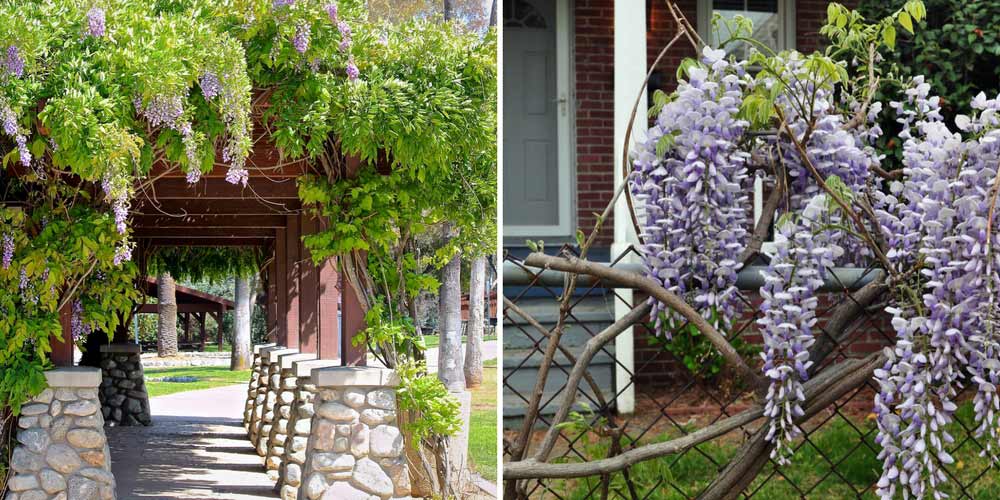 Prefer to let your wisteria climb on a proper wooden pergola rather than on a simple wire mesh!
Prefer to let your wisteria climb on a proper wooden pergola rather than on a simple wire mesh!
Read also
Wisteria: how to plant, prune and care?Guide its branches
As soon as you plant it, start guiding its stems onto the support, tying them with raffia. In the following years, this will no longer be necessary, as the plant will wrap itself around its support. You can simply redirect those that go in the wrong direction. Start by guiding the wisteria upwards along its support, then, when it has reached the desired height, you can direct it horizontally, for example, over the top of a pergola or under a window. This way, it is possible to run wisterias all around a house. You can also have it completely cover a façade.

You can guide your wisteria against the wall of your house.
Discover other Wisterias
View all →Available in 0 sizes
Available in 0 sizes
Available in 0 sizes
Available in 0 sizes
Available in 2 sizes
Available in 1 sizes
Available in 0 sizes
Available in 1 sizes
Available in 3 sizes
Available in 1 sizes
Prune it regularly
Vigorous and robust, wisteria tolerates pruning very well: you can prune it up to four times a year if necessary! Prune it every year to restore some order and prevent its branches from going in all directions! There are three main pruning periods: winter, spring, and summer.
Make clean cuts, just before a node (the point where leaves attach to the stem), using a pruning shear. We recommend disinfecting it before use, with methylated spirits or 90° alcohol, to avoid transmitting diseases from one plant to another. In general, leave at least three nodes on each stem. Take the opportunity to remove damaged or poorly formed branches. It is also possible to carry out severe pruning to rejuvenate the wisteria, provided enough healthy branches are retained to avoid putting it at risk.
In winter:
During winter, wisteria is in a dormant state. Take this time to give it a balanced shape. Cut back three buds on each branch that is growing too far outwards or in the wrong direction. Remove any shoots that may develop at the base of the trunk. Prune outside of frost periods.
In spring:
Prune in March or April, when growth resumes. This pruning will make your wisteria’s flowering more generous! It encourages the formation of flower buds by directing sap more directly to them. Prune the previous year’s shoots, which are still green, leaving at least three buds each time.
In summer:
The goal is to direct the plant’s growth and prune branches that are going in the wrong direction. Guide the stems back to their support and shorten the longest branches by a third.
→ Also read: When and how to prune a wisteria?

Over time, wisteria often takes on impressive proportions. Hence the importance of choosing a sturdy and durable support!
How to prune wisteria into a tree?
Training wisteria as a tree is a technique that requires a lot of time but allows you to highlight the flowering and architecture of this magnificent climbing plant! With a great deal of patience, you can achieve a lovely umbrella habit. Place it isolated in the middle of a short grass meadow as a focal point.
- Plant it with a straight and sturdy support, tall enough. A large chestnut wood stake would be perfect. It is imperative to choose a strong tutor; otherwise, when it reaches a significant height, the wisteria may fall over under its weight.
- Guide one or more shoots along this tutor.
- Attach them to the tutor with ties made of raffia. There’s no need to wrap them around; instead, try to make them grow straight.
- Systematically cut back the lateral shoots that develop along the trunk.
- When the plant has reached a sufficient height (at least 1.5 m or 2 m), retain only four or five branches from the top, cutting them back to three buds.
- Prune the other stems back to the trunk. The few branches you have selected will form the architecture of the plant by branching out and will give rise to other stems.
- Continue to prune and maintain your wisteria regularly year after year!
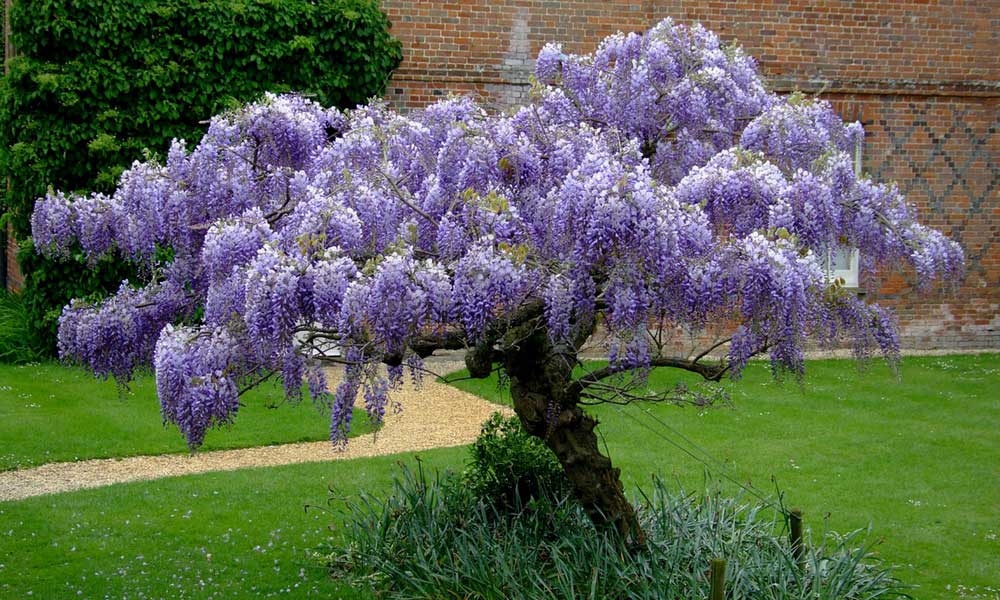
A wisteria trained as a tree (photo Charles Miller)
To go further
- Discover all our tips for growing a wisteria in a pot
- Browse our advice sheet: How to associate a wisteria?
- Subscribe!
- Contents
































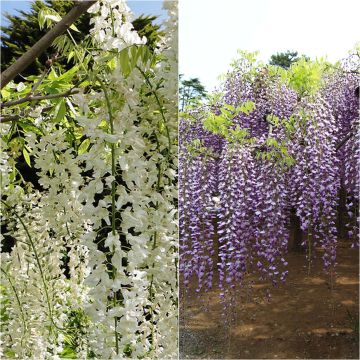

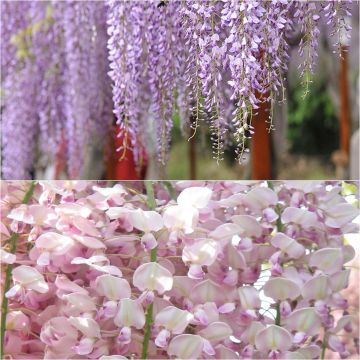
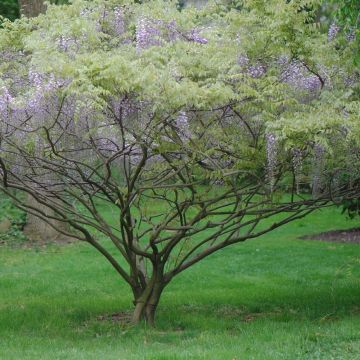

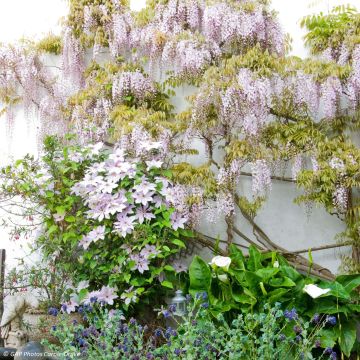

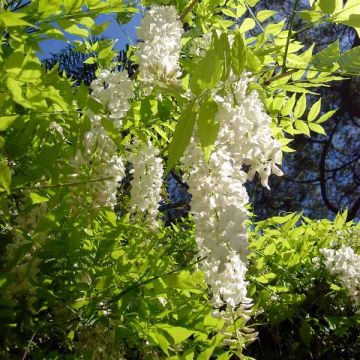

Comments